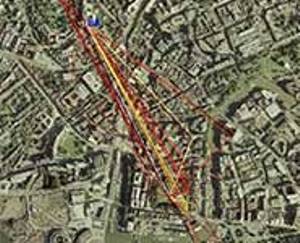Jun 6 2013
Collaborative research between the University of Bristol and Nokia Siemens Networks is enabling the design and optimization of novel 3D antenna arrays.
 3D ray tracing from a base station (BS) to a mobile phone (UE). The colour of the ‘rays’ denote their strength (lighter being stronger). Image by Professor Andrew Nix
3D ray tracing from a base station (BS) to a mobile phone (UE). The colour of the ‘rays’ denote their strength (lighter being stronger). Image by Professor Andrew Nix
Today’s cellular phone networks are struggling to meet the capacity demands of modern smart phones. Researchers at the University of Bristol have been supported by Nokia Siemens Networks to find new ways of delivering a 1000x capacity boost by 2020.
Multiple antennas, known as MIMO, are already used to enhance the data rate in many leading WiFi routers.
Today’s cellular systems are looking to exploit multiple antennas by spacing two or more elements in the horizontal plane. This technology is exploited as part of the Long Term Evolution (LTE) and LTE-Advanced mobile phone standards, commonly known as 4G.
Andrew Nix, Professor of Wireless Communication Systems in the University’s Department of Electrical and Electronic Engineering, who leads this project, said: “Large capacity gains can be achieved by deploying a layer of much smaller cells and by exploiting multiple antenna technology at both ends of the link.”
A joint paper with Nokia Siemens Networks was presented this week [Monday 3 June] at the IEEE International Conference on Vehicular Technology in Dresden, Germany. It proposes a 3D radio channel model that allows the benefits of 3D MIMO arrays to be quantified. This model has been designed as a simple extension to the current 2D 3GPP/ITU channel model.
In the paper, ray-tracing data from the University of Bristol’s unique outdoor ray tracer (ProPhecy) is used to provide a distance-dependent elevation spread. Hundreds of thousands of base station to mobile phone links were simulated to generate these new 3D statistics.
Professor Nix added: “Real-world measurements at this kind of scale simple aren’t practical or cost-effective in practice.”
The paper suggests a 3D channel model that is easy to use and easy to implement for 3GPP evaluations. To ensure backwards compatibility, most of the parameter generation has been kept from the current 3GPP/ITU channel models.
Evangelos Mellios, a final-year PhD student who helped develop the model, explained: “We added the generation of elevation angles using a distance-dependent elevation spread to the model.”
The paper concludes by showing the importance of proper 3D channel modelling in understanding the performance of vertical sectorization in future cellular networks.
Two papers on this subject have already been presented to 3GPP (Malta, February 2013). It is anticipated that some form of 3D model will be agreed in 3GPP before the end of the year.
Professor Nix concluded: “Better understanding of the radio channel is critical, and this new work opens up the possibility of new capacity gains through the use of 3D MIMO.”